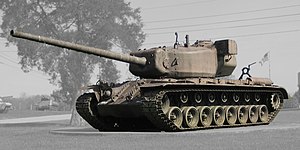T29 heavy tank
| Heavy Tank T29 | |
|---|---|
 | |
| Type | Heavy tank |
| Place of origin | |
| Service history | |
| In service | trials only |
| Used by | United States Army |
| Production history | |
| Designed | 1944 |
| Variants | T29E1, T29E2, and T29E3 |
| Specifications | |
| Mass | 141,500 lbs (70.5 short tons, 64.2 metric tons) combat loaded |
| Length | 37 ft 11.5 in (11.57 m) gun forward, 32 ft 9 in (10 m) gun aft |
| Width | 12 ft 5.5 in (3.80 m) over sand shields |
| Height | 10 ft 6 in (3.20 m) over cupola |
| Crew | 6 (driver, commander, gunner, loader {left}, loader {right})[1] |
| Armor | hull front upper 4 in (102 mm) at 54 degrees hull front lower 2.75 in (70 mm) at 58 degrees gun shield 8 to 11 inches (203 to 279 mm) turret front 7 in (178 mm) at 0 degrees turret sides 5 in (127 mm) at 0 degrees[1] |
Main armament | 105 mm gun T5E2 (63 rounds) |
Secondary armament | 2 x .50 (12.7mm) Browning M2HB machineguns, coaxial 1x .50 M2HB flexible AA (2,420 rounds) 1x .30 Browning M1919A4, bow (2,500 rounds) |
| Engine | 1649 cubic inch (27 liter) Ford GAC four cycle 60 degree V12[1] gasoline 650 net hp at 2800 rpm, 770 gross hp at 2800 rpm |
| Power/weight | 10 hp/tonne |
| Transmission | General Motors CD-850-1 crossdrive, three speeds (two forward, one reverse); rear drive sprocket |
| Suspension | torsion-bar |
| Fuel capacity | 300 US gallons (1140 liters), 80 octane |
Operational range | 100 miles (160 km) |
| Maximum speed | 22 mph (35 km/h) |
The Heavy Tank T29 was an American heavy tank project started in March 1944 to counter the new German heavy tanks. The T26E3 (M26 Pershing), weighing around 45 tonnes, was not considered heavily enough armed or armored to counter the Tiger II, which weighed closer to 70 tonnes. The T29 was not ready in time for the war in Europe, but it did provide post-war engineers with opportunities for testing the engineering concepts in artillery and automotive components.
The T29 was based upon a lengthened version of the T26E3 hull and featured heavier armor, an uprated Ford GAC engine providing about 770 bhp (570 kW) gross, 650 bhp (480 kW) net, more comfortable controls for the driver,[2] and a massive new turret incorporating the high velocity 105 mm gun T5. It weighed about 70 tons and was highly comparable to the German Tiger II in terms of both firepower and protection. Other trial models had Allison V1710 V12 engines.[3]
Developed at the same time and closely related to the T29, the T30 Heavy Tank was virtually identical but mounted a 155 mm gun T7 and featured a more powerful engine and an extra crew member to help load the gun. In 1945, with the war in Europe already over, the T29 and T30 were classified "limited procurement" and a small order proposed on the basis that their large guns and heavy armor would be useful for attacking Japanese bunkers. Army Ground Forces command, however, objected to the deployment of such heavy vehicles and the war ended before the issue was resolved, so only a small batch of pilot models were constructed.
The final variation of the T29 concept, the Heavy Tank T34, mounted a 120mm gun based upon the then-current 120mm anti-aircraft gun. There were only two prototypes, one converted from one of the T29 pilot models and one converted from a T30. Once again, the end of the war curtailed further development, but the experience gained with the T34 was valuable in the development of the M103 heavy tank.
The T29 featured a coincidence rangefinder projecting from both sides of the turret.
There are a couple surviving T29s on post at Fort Benning, Georgia. One is located in front of the National Armor & Cavalry Museum.
See also
There are two T29's surviving, both at Sand Hill at Fort Benning, Georgia. They are being stored in preparation for the new Armor exhibit. One has the distinctive rangefinder, while the other does not. Both can be seen as well as many other vehicles in a fenced enclosure on 25 Infantry Regiment Road. There is also a surviving T-29 without the rangefinder at the Detroit Arsenal in Warren, Michigan.
